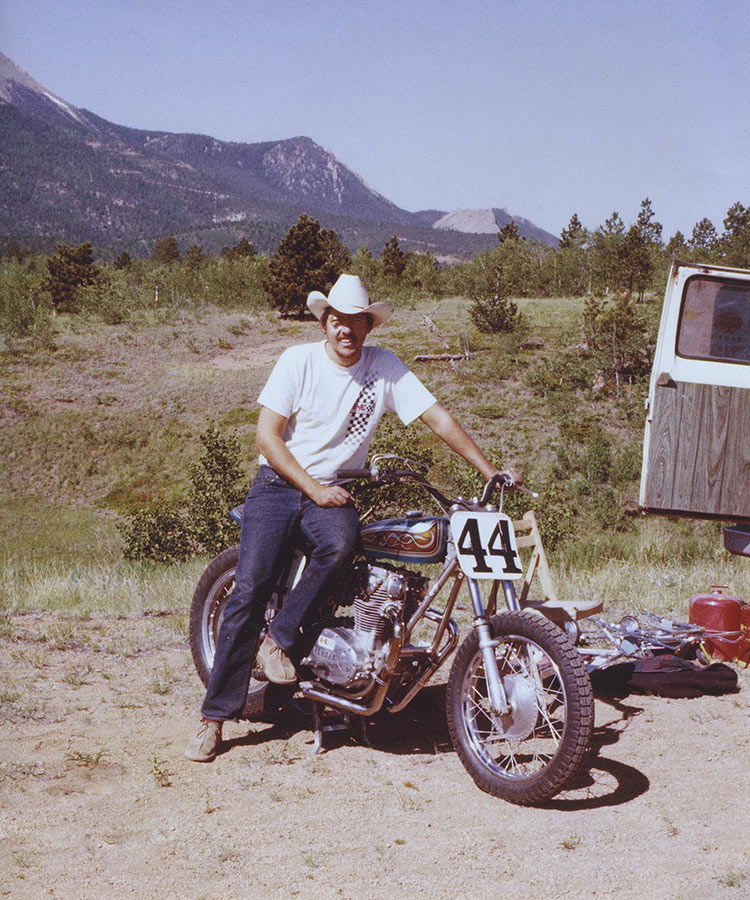Riding
Prom Queen
A Yamaha Street Tracker With A Mysterious Past
By David Christian
If my math is correct, Mike LaCoco would have been 15 years old in 1945 when, in the predawn darkness of a New Mexico night, a roar and a blinding light ushered the world into the Atomic Age.
Whatever LaCoco’s thoughts were at that time, they surely didn’t include sitting 25 years later in his motorcycle dealership in Alamogordo, staring at three Yamaha twin-cylinder engines and three Trackmaster frames.
This is the story of those three bikes and the people who touched them—and were touched by them—for a half-century.
My part of the story begins with an unusual coincidence.
I was born in 1946 in Clovis, N.M. A few years ago, I was visiting friends and relatives when I mentioned to my high school buddy, Larry Baughman, that I wanted a project bike based on Yamaha’s charismatic XS650 engine.
“Well,” he said. “I have an old flat-track bike that I might sell you.”
Based on what I could see in Larry’s dimly lighted barn, the bike looked like a great starting point for a street tracker.
Larry purchased the bike in the late 1970s from Bobby J’s Yamaha in Albuquerque, the oldest Yamaha dealer in the United States. It appeared to be in one piece, and I loved the shape of the lightweight, competition-style gas tank.
We agreed on a price, and thus began an adventure impossible to predict.
Some months later, I was back in New Mexico, and I stopped to see Larry. When I walked into his barn, I was stunned. The Yamaha was wearing a completely different gas tank and seat, with a wild metal-flake paint job.
I laughed out loud. Perfect!
Larry said they didn’t race the bike much with the metal-flake tank and seat—too heavy—but I could have either combination.
Channeling my inner Evel Knievel and Elvis Presley, I immediately saw the path for my project bike.
I took a number of pictures and showed a couple of them to Johnny Middleton, a highly regarded hot-rodder and muscle-car builder, who happened to be my neighbor in nearby Portales. Some years earlier, I inherited a portion of my grandparents’ small farm, and I got to know Johnny well.
Little did I know the ramifications of that meeting.
Middleton had an internet thread going with his buddy, Jimmy Allison, and a few others. One of them, Arthur “Robbie” Robertson, wondered what happened to the bike he raced at Pikes Peak on July 4, 1976. He even posted a photo of the machine.
“Look what I found,” Middleton excitedly told Robertson.
Johnny phoned to tell me that he had seen a picture of my bike at Pikes Peak, with a drum front brake. That is impossible, I replied. My bike doesn’t have a front brake.
But Middleton was adamant, and photos confirmed it was the same bike. Kent Eves’ period metal-flake paint is as distinctive as a fingerprint.
The door to the past was open.

▲ Joe Pearce flat-tracks the Trackmaster-framed Yamaha in 1971.
In The Beginning
As the story goes, LaCoco and Lloyd Morrison of La Luz built three race bikes—a heavily modified 650, a mildly modified 650 and a mildly modified 750—all likely pulled from inventory at LaCoco’s dealership.
Joe Pearce, a prominent flat-track racer who worked for LaCoco, destroyed the hot 650 in July 1972 at a track in Colorado. Sadly, the crash cost Pearce his lower right leg.
LaCoco and Pearce later found the mild 650 in a pile of parts behind the shop. They got the engine running, built a chopper, and Pearce, sporting an artificial limb, led a rally from Alamogordo to El Paso, Texas.
Pearce also rode the 750 a few times.
At some point, LaCoco sold the 750 to Bruce Rathbun in El Paso. Rathbun Motors was a Yamaha dealer in El Paso prior to Sherman Barnett of Barnett Harley-Davidson fame. In 1974, Rathbun sold the bike to Pearce, who loaned it to Robertson for the Pikes Peak bicentennial race.
Still with me?

▲ Arthur “Robbie” Robertson poses at the Pikes Peak bicentennial hillclimb.
Robertson Picks Up The Story
“I ran a right-side shifter and a right-side rear brake on the bike at the hillclimb,” Robertson said. “Brake and shift levers on the right side were the common setup for flat track. Looking at some of the later pictures from the flat-track races, I may have put it back to stock.
“I have no recollection where I got the front wheel with the drum brake. Did Joe put it on for me?
“I raced the bike at a 3/8-mile track near Las Cruces in the summer of ’76. We had motorcycle races during the intermission for the weekly car races. I raced there three years on my Trackmaster Yamaha TD2B in ’73, my Trackmaster BSA 650 that I bought from Larry Baughman in ’74 and Joe’s bike in ’76.”
In 1977, Bruce Hanson, a flat-track racer and friend of Pearce, bought the Yamaha. The following year, Hanson sold the bike to Bobby J’s. The bill of sale was left open, so the paperwork reflects an April 26 transaction between Hanson and Baughman.
A Question Of Displacement
So, where are the three bikes now?
The “slower” of the two 650s was dusted off and built into a chopper. The last time Pearce saw the “fast” 650 it was cartwheeling off a racetrack, perhaps headed to Denver.
And the 750?
“You’ve got it—maybe,” Robertson said.
Hanson, who bought the bike from Pearce and is a skilled fabricator and mechanic, swears the bike he owned was a 650. Bobby J’s, he said, planned to make it a 750.
A look inside one of the cylinders with a borescope revealed the distinctive lip of a bigger piston, so unless Bobby J’s performed the aforementioned engine work, which is possible, this is the original 750.
“Joe said the bike I rode at Pikes Peak and the one you have is the 750,” Robertson said. “He said it didn’t have a lot of hop-up stuff like the hot-rod 650—the one he crashed. He said your bike only had the big cylinder kit.”

▲ Author David Christian shows the bike in TT trim at the Quail Motorcycle Gathering in Carmel, Calif.
Photo by Jim Palam
A Mystery That May Never Be Solved
Regardless of its actual displacement, my engine has 34mm Mikuni carburetors, porting, probably a different cam, a lightened flywheel and a lot of compression—all the usual hop-up work.
As the years passed, I brought the ol’ gal back to life in several iterations, the latest being a licensed street tracker, and showed it twice at the Quail Motorcycle Gathering in Carmel, Calif.
People who don’t like motorcycles like this bike. Some have told me it reminds them of high school. It makes them smile.
So, I took the liberty of giving her a name, much like the fighters and bombers in World War II.
“Prom Queen” just seemed to fit.
David Christian is an AMA member from Palm Springs, Calif.




